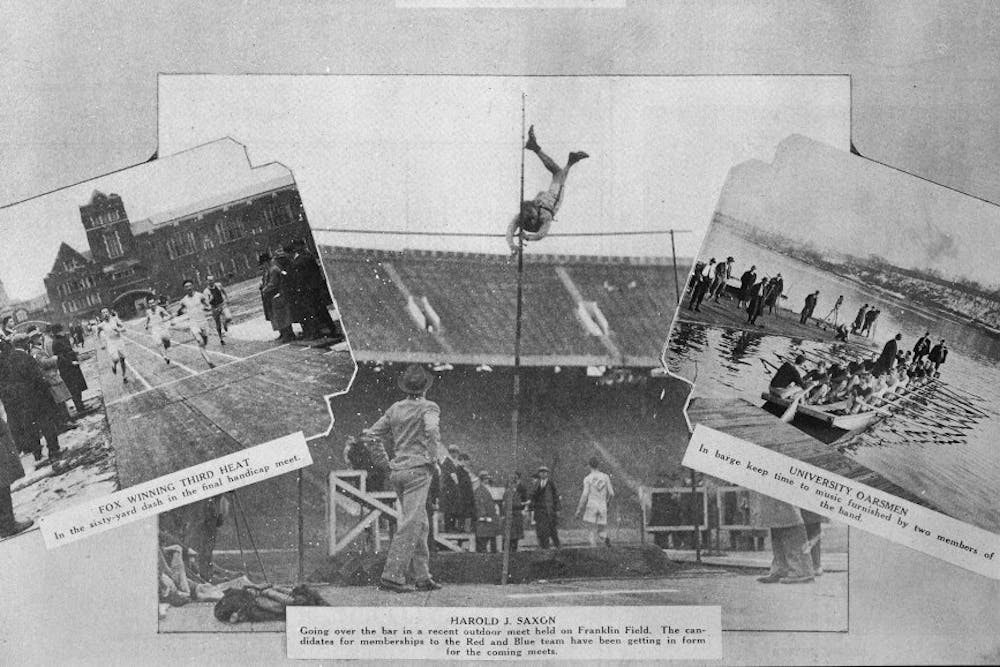
Events that occurred in sports in 1927 (from left to right): Fox wins third heat in the 60-yard dash, Saxon goes over the bar during an outdoor meet on Franklin Field, and University Oarsmen in barge keep time to the band.
Credit: DP ArchivesMuch like last year, 1918 was an unusual year for sports at the University of Pennsylvania. While entire seasons weren’t canceled for all teams, sports at the university were undoubtedly affected. But in 1919, just like in 2021, things were starting to go back to normal for Penn sports.
In 1918, not only were sports affected by the global pandemic, but World War I loomed large over the school. The SATC (Students’ Army Training Corps), encouraged all male students to play for school sports in order to stay physically fit in case they were drafted (Penn did not establish a Women’s Athletic Association until 1921). As a result, SATC students not only played sports, but also participated in military exercises and ate in military style mess halls to prepare for the possibility of being drafted. Additionally, teams at Penn were no longer representing Penn, but represented SATC at Penn.
These changes were short-lived, however, as the war ended in November 1918, only a few months after the establishment of SATC. Despite this, many players on the swimming and water polo teams enlisted, leaving the teams shorthanded for the year.
Things were further complicated by the influenza. The entire athletics season wasn’t canceled like it was in 2020, but many sports played incomplete seasons, while some didn’t play at all.
The pool was closed to the swimming team on and off throughout the season. Crew had its season canceled and the team’s coach left after his wife contracted the flu. Soccer also had its entire season postponed. Football managed to play a full season despite a four-game ban, but players had to wear gauze masks at times and many games were canceled.
Coming back into the 1919 season, it looked like things would be normal again. The war was long over and the influenza, despite rearing its ugly head with three separate waves in the country, seemed to no longer be affecting the U.S. This return to normalcy resulted in full seasons for Penn sports once again.
Soccer, which had its entire intercollegiate season canceled in 1918, played against another school for the first time in 710 days on Nov. 1, 1919. They took on Princeton, the team they had defeated in 1916 for the league championship. The Quakers decimated the Tigers, 5-1, cementing themselves as favorites to win another league title.
The Quakers rolled through the remainder of the season, winning the next five games without giving up a goal. The Red and Blue defeated Yale, Harvard, Dartmouth, and Cornell, scoring 14 goals over the span of four games.
The Quakers then took on Haverford on Dec. 6 at Franklin Field with a chance to take home the intercollegiate championship. Penn hadn’t beaten Haverford since 1914 and their most recent match had come in 1917, when the Scarlet and Black beat the Quakers to take home the college championship. All of this didn’t matter, however, as Penn won a decisive 3-1 game, completing their perfect season and taking home the championship for the third time in four years.
For football, 1919 represented normalcy after the strange 1918 season. In 1917, the Quakers managed their only bowl appearance, losing to Oregon 14-0 on the heels of a 9-2 season. In 1918, with the pandemic and the war hanging over their heads, and games being canceled, the Quakers managed to go 5-3, a mediocre follow up to the success of the previous season.
This made the 1919 season all important for the Quakers, as they tried to prove that 1918 was a fluke caused by the multitude of confounding factors. And prove that they did, winning their first five games while outsourcing opponents by a whopping 237-7. Led by future NFL commissioner Bert Bell at quarterback, the Quakers were on track to vie for the national championship.
This led to a matchup with rival Penn State, who were 3-1 on the season. With 20,000 fans packing into Franklin Field on Nov. 1, the Red and Blue needed a win to prove themselves as contenders. The Quakers were unable to do so, however, dropping the game 10-0, a loss that ultimately proved too much for the Red and Blue to overcome, as they finished thee last three games of the season 1-1-1, posting a final record of 6-2-1.
Overall, the season proved to be the beginning of a successful turnaround for the Quakers, as 1919 set the tone for the prosperous next decade for the program. Penn went 65-25-4 in the 1920s.
The 1919 season was an important one for the athletic program at Penn, as the return to normalcy allowed for triumphant seasons for the football and soccer teams, which paved a path for the next decade of success for these programs.
The Daily Pennsylvanian is an independent, student-run newspaper. Please consider making a donation to support the coverage that shapes the University. Your generosity ensures a future of strong journalism at Penn.
Donate







